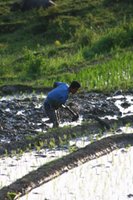
In average, a village in this area consists of around 2,500 people, and a family usually consists of 4 members (Mother, father and two children). Most of the people finished elementary school, while some managed to get through junior high school. Only a few finished Senior high school. These communities are accessible through a bad road condition to the provincial road that eventually connects to the toll highway (around 250 km from the capital city
Each household usually has one or two sources of income (the father and the mother work) with average income ranging from IDR 390,525 to IDR 790,265 per month. Although many people work in the paddy fields, many of them also open an agriculture area in the forest. Part of the Park used to be a forest estate owned by Perhutani, a government owned mahogany plantation. Local people (workers) were allowed to cultivate vegetables, rice, and fruits in the estate. Later on, when the area was converted into a National Park, these people continued to maintain their farm inside the Park, and even further expand into the forest areas. It is clear that people residing near Park’s territory rely on forest resources for daily subsistence.


















